The Sombrero Galaxy (Messier 104) is a bright peculiar galaxy located approximately 31.1 million light-years away in the constellation Virgo. It has the designation NGC 4594 in the New General Catalogue. With an apparent magnitude of 8.0 and an apparent size of 9 by 4 arcminutes, the galaxy can be observed in small and medium telescopes.
The cosmic Sombrero is one of the brightest galaxies in the night sky. Its brightness makes it a popular target for amateur astronomers and astrophotographers. The galaxy’s unusual shape, the central supermassive black hole, and features that indicate both a spiral and an elliptical galaxy have long puzzled professional astronomers as well. Messier 104 is one of the most studied astronomical objects in the sky.
The Sombrero Galaxy is slightly larger than our own Milky Way. It has an isophotal diameter of 94,900 to 105,000 light-years. The galaxy appears almost edge-on, with an inclination angle of 84°.3. It has one of the most massive central black holes known.
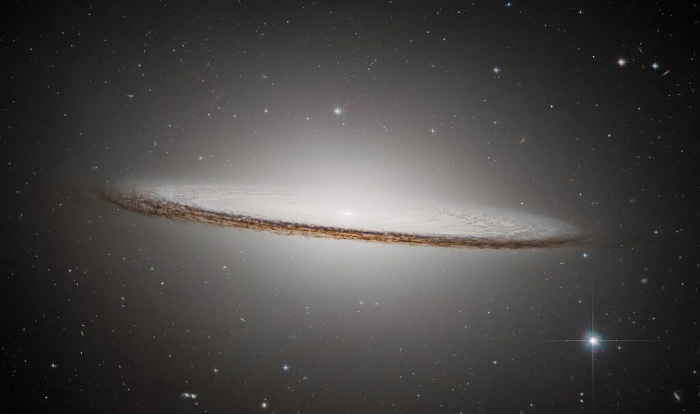
Located around 30 million light-years away in the constellation Virgo, the Sombrero Galaxy is instantly recognisable. Viewed nearly edge on, the galaxy’s softly luminous bulge and sharply outlined disc resemble the rounded crown and broad brim of the Mexican hat from which the galaxy gets its name. Though the Sombrero Galaxy is packed with stars, it’s surprisingly not a hotbed of star formation. Less than one solar mass of gas is converted into stars within the knotted, dusty disc of the galaxy each year. Even the galaxy’s central supermassive black hole, which at 9 billion solar masses is more than 2000 times more massive than the Milky Way’s central black hole, is fairly calm. The galaxy is too faint to be spotted with unaided vision, but it is readily viewable with a modest amateur telescope. Seen from Earth, the galaxy spans a distance equivalent to roughly one third of the diameter of the full Moon. The galaxy’s size on the sky is too large to fit within Hubble’s narrow field of view, so this image is actually a mosaic of several images stitched together. The Sombrero Galaxy is an oblong, pale white disc with a glowing core. It appears nearly edge-on but is slanted slightly in the front, presenting a slightly top-down view of the inner region of the galaxy and its bright core. The outer disc is darker with shades of brown and black. Different coloured distant galaxies and various stars are speckled among the black background of space surrounding the galaxy. Image credit: ESA/Hubble & NASA, K. Noll (CC BY 4.0)
The galaxy’s morphological type is uncertain. M104 has been classified both as a spiral galaxy and as an elliptical galaxy.
The Sombrero Galaxy has a large central bulge and a bright nucleus partly obscured by a dark dust lane in the galaxy’s outer disk. The dense ring of dust and the unusually prominent bulge give the galaxy the appearance of the broad-brimmed Mexican hat known as the sombrero. The thick dust lanes are part of the galaxy’s spiral structure.
The Sombrero Galaxy was long believed to be a spiral galaxy because astronomers thought that its halo was small. However, observations with NASA’s Spitzer Space Telescope in 2012 revealed the halo to be much larger than previously thought. The massive galactic halo indicates that M104 is in fact a giant elliptical galaxy.
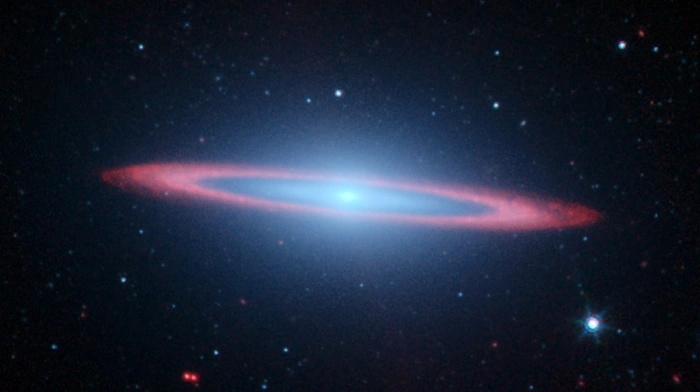
NASA’s Spitzer Space Telescopes created this striking infrared image of one of the most popular sights in the universe. Messier 104 is commonly known as the Sombrero galaxy because in visible light, it resembles the broad-brimmed Mexican hat. However, in Spitzer’s striking infrared view, the galaxy looks more like a “bull’s eye.” In visible light images, only the near rim of dust can be clearly seen in silhouette. Recent observations using Spitzer’s infrared array camera uncovered the bright, smooth ring of dust circling the galaxy, seen in red. Spitzer’s infrared view of the starlight, piercing through the obscuring dust, is easily seen, along with the bulge of stars and an otherwise hidden disk of stars within the dust ring. Spitzer’s full view shows the disk is warped, which is often the result of a gravitational encounter with another galaxy, and clumpy areas spotted in the far edges of the ring indicate young star-forming regions. Credit: NASA/JPL-Caltech/R. Kennicutt (University of Arizona) and the SINGS Team (PD)
The Sombrero Galaxy is both a disk galaxy and an elliptical galaxy. Elliptical galaxies are featureless glowing balls composed mostly of old stars, with minimal star formation. Disk galaxies – spiral and lenticular galaxies – look like disks, with a central bulge and a flattened, rotating volume of stars, dust and gas orbiting the galactic core in the same plane.
Astronomers explain the unusual morphology of the Sombrero Galaxy by thinking of it as two galaxies, one inside the other. They suspect that M104 is similar to Centaurus A, another elliptical galaxy containing a disk, located in the constellation Centaurus. However, Centaurus A may be younger and might eventually look similar to the Sombrero.
The process that produced such an unusual structure in the Sombrero Galaxy remains unclear. If a giant elliptical galaxy had absorbed a smaller spiral galaxy, the smaller galaxy’s disk would have been torn apart. If, on the other hand, a gas cloud was pulled in by the gravity of the larger elliptical galaxy over 9 billion years ago, it may have fallen into orbit around the galaxy’s core to form a rotating disk.
The nucleus of Messier 104 is classified as a LINER (low-ionization nuclear emission-line region) and believed not to host any significant star forming activity. The active galactic nucleus (AGN) contains the galaxy’s central supermassive black hole, which has a mass of around 9 billion solar masses. The Sombrero’s central black hole is the likely source of the weak ionization of the gas in the galaxy’s core.
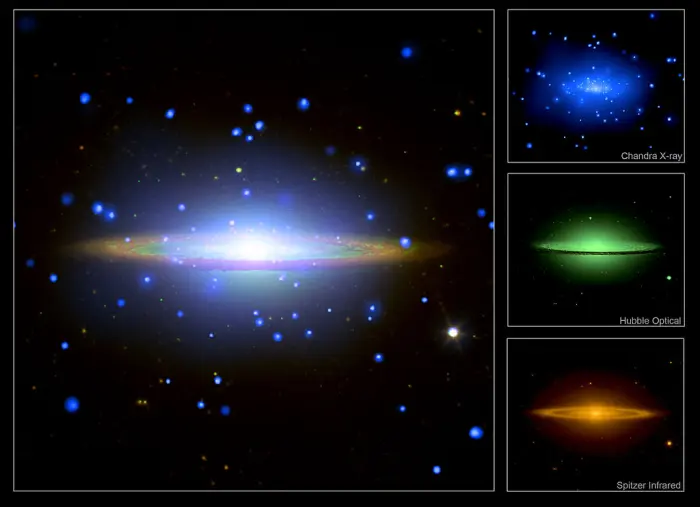
This Great Observatories view of the famous Sombrero galaxy was made using Chandra, Hubble, and Spitzer. The main figure shows the combined image from the three telescopes, while the inset images show the separate observatory views. Chandra’s X-ray image (in blue) shows hot gas in the galaxy and point sources that are a mixture of objects within the galaxy and quasars in the background. Hubble’s optical image (green) reveals the bulge of starlight partially blocked by a rim of dust, which glows brightly in Spitzer’s infrared view. Credit – Chandra (X-ray): NASA/UMass/Q.D.Wang et al.; Hubble (optical): NASA/STScI/AURA/Hubble Heritage; Spitzer (infrared): NASA/JPL-Caltech/Univ. AZ/R. Kennicutt/SINGS Team (PD)
The giant dust lane that encircles the galaxy’s bright bulge is a symmetrical ring that contains most of the galaxy’s dust, cold atomic hydrogen gas, and possibly most of its cold molecular gas. Spectroscopic observations at infrared wavelengths indicate that the large dust ring is the most prominent star formation site in the Sombrero Galaxy. However, the ring forms less than one solar mass of stars per year. In comparison, the Milky Way produces around 2 solar masses per year.
The Sombrero Galaxy was imaged by the James Webb Space Telescope’s powerful Mid-Infrared Instrument (MIRI) in November 2024. The MIRI image showed the clumpy nature of the Sombrero’s dusty disk. The galaxy’s bright, glowing core that dominates the visible-light images taken by Hubble only appears as a smooth inner disk in the mid-infrared band. Webb’s MIRI instrument also detected polycyclic aromatic hydrocarbons in the Sombrero’s dust ring. These carbon-containing molecules may be evidence of very young regions of star formation.
The James Webb telescope has provided scientists with new insights into how dust is distributed in the Sombrero Galaxy’s outer ring, revealing the dust clumps at high resolution at infrared wavelengths for the first time. The infrared space telescope has also captured distant background galaxies that appear in the same field of view as M104. The colours of these galaxies indicate some of their properties, including distance.
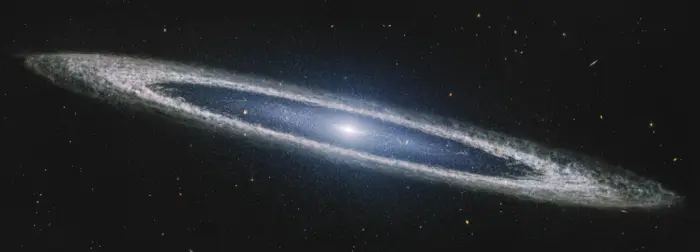
The NASA/ESA/CSA James Webb Space Telescope recently imaged the Sombrero galaxy with its MIRI (Mid-Infrared Instrument), resolving the clumpy nature of the dust along the galaxy’s outer ring.The mid-infrared light highlights the gas and dust that are part of star formation taking place among the Sombrero galaxy’s outer disk. The rings of the Sombrero galaxy produce less than one solar mass of stars per year, in comparison to the Milky Way’s roughly two solar masses a year. It’s not a particular hotbed of star formation. Credit: NASA, ESA, CSA, STScI (CC BY 4.0)
Black hole
The supermassive black hole at the centre of the Sombrero Galaxy is among the most massive black holes discovered in any nearby galaxy. With an estimated mass of 8.83 billion solar masses, it is the closest black hole with such an exceptionally large mass to the Sun and one of the most massive objects in the Milky Way’s neighbourhood. It is more than 2,000 times more massive than Sagittarius A*, the black hole at the centre of our own galaxy, the Milky Way. Sagittarius A* has an estimated mass of 4.1 million Suns.
The central black hole in the Sombrero Galaxy was first detected by a team led by John Kormendy in the 1990s, during observations with the Hubble Space Telescope (HST) and the Canada–France–Hawaii Telescope (CFHT) on Mauna Kea in Hawaii. The researchers used information obtained with the HST and CFHT to demonstrate that the stars near the galaxy’s centre could not maintain their speed of revolution unless the centre contained a mass equal to that of a billion suns.
Despite its enormous mass, the Sombrero Galaxy’s supermassive black hole is not particularly active. It is a low luminosity active galactic nucleus with a relatively small jet.
Size
The Sombrero Galaxy is slightly larger than the Milky Way. It has a diameter of 94,900 to 105,000 light-years and an estimated mass of 800 billion solar masses.
The Sombrero Galaxy contains a large number of globular clusters. Astronomers estimate that it has a population of around 2,000 globulars. The number of these objects – about 10 times larger than the number of globular clusters in the Milky Way galaxy – is believed to be related to the size of the Sombrero’s large bulge. The clusters have an estimated age of 10 to 13 billion years.
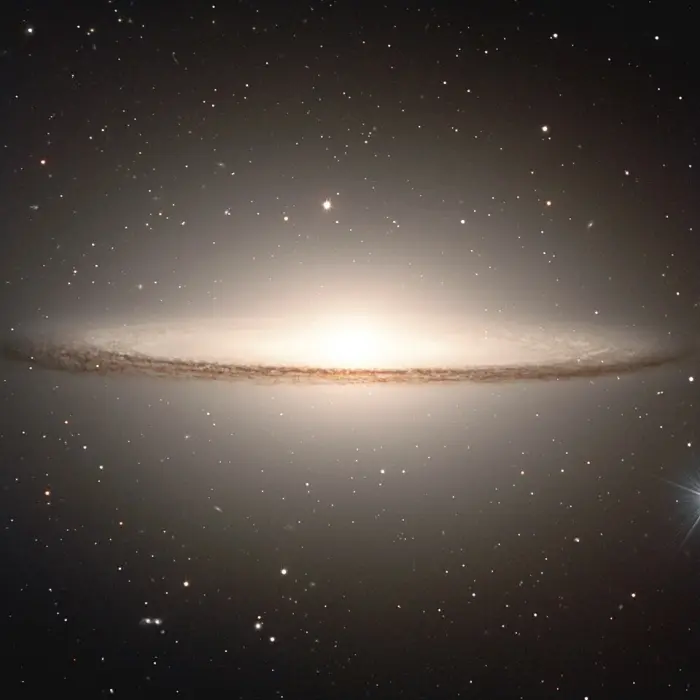
Image of the famous early-type spiral galaxy Messier 104, widely known as the “Sombrero” (the Mexican hat) because of its particular shape. Image credit: ESO (CC BY 4.0)
Distance
The Sombrero Galaxy lies at a distance of 31.1 ± 1.0 million light-years (9.55 ± 0.31 megaparsecs). The distance was measured based on the tip of the red-giant branch method using data obtained with the Hubble Space Telescope in 2016.
Other methods have yielded different values. In 1996, astronomers calculated a distance of 29 ± 2 million light-years (8,890 ± 610 kiloparsecs) by comparing the measured fluxes of the planetary nebulae in M104 to the luminosity of Milky Way’s planetary nebulae.
In 1997 and 2001, researchers used the surface brightness fluctuations method to derive a distance of 30.6 ± 1.3 Mly (9,380 ± 400 kpc) and then refine it to 32 ± 3 Mly (9,810 ± 920 kpc). The distance was further refined to 29.6 ± 2.5 Mly (9,080 ± 770 kpc) in 2003.
The Sombrero Galaxy is moving away from us at around 1,024 km/s. The galaxy’s recession speed was first measured in 1912. At the time, it was the largest redshift ever measured and one of the first indicators that the Universe was expanding.
Facts
The Sombrero Galaxy was discovered by the French astronomer Pierre Méchain on May 11, 1781. Méchain’s friend and colleague Charles Messier noted the discovery, but did not include the object in his original catalogue. Messier described Méchain’s discovery as a “very faint nebula” in his personal copy of the French yearly publication Connoissance des Temps in 1784.
It was the French astronomer Camille Flammarion who added the galaxy to the Messier catalogue in 1921, based on Messier’s handwritten note that mentioned the six objects that were later catalogued as M104 – M109. Messier’s object was identified as NGC 4954 in the New General Catalogue and became Messier 104.
Pierre Méchain described the object in a letter to J. Bernoulli on May 6, 1783. He wrote, “On May 11, 1781, I have discovered a nebula above Corvus; it did not appear to me to contain stars; it is faint & very difficult to see when the wires of the micrometer are illuminated.” The letter was published by Johann Elert Bode in the Berliner Astronomisches Jahrbuch for 1786.
The German-British astronomer William Herschel discovered the galaxy independently on May 9, 1784. He made a note of the “dark stratum” (dust lane) in the disk of M104. His son John Herschel observed M104 on March 9, 1828.
The Herschels were unaware of Méchain’s discovery. For this reason, the discoverer’s name is not mentioned in the New General Catalogue, compiled by Danish astronomer John Louis Emil Dreyer in 1888. Dreyer’s catalogue was based on the work of William, Caroline and John Herschel.
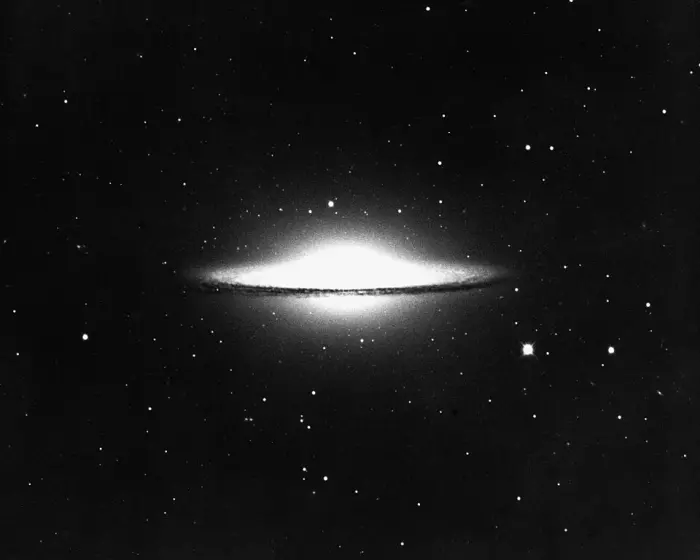
The Sombrero Galaxy in the constellation Virgo, as seen by the KPNO 4-meter Mayall telescope in 1974. Credit: NOIRLab/NSF/AURA (CC BY 4.0)
The Sombrero Galaxy is the only Messier galaxy in the constellation Virgo that is not a member of the Virgo Cluster. It is a member of the Virgo II Groups, a series of over a hundred galaxies and galaxy clusters spanning around 30 megalight-years in diameter off the southern edge of the Virgo Supercluster.
Also known as the Virgo II Cloud, the Virgo S Cloud, and the Virgo Southern Extension, the filament-like cloud of galaxies lies at a distance of 55 to 80 million light-years from our own solar system. Other bright members include the Swelling Spiral Galaxy (Messier 61), the grand design spiral galaxy NGC 4030, the elliptical galaxy NGC 4697 (Caldwell 52), the intermediate spiral NGC 4699, the lenticular galaxy NGC 4753, and the barred lenticular galaxy NGC 4856.
It is uncertain whether or not the Sombrero Galaxy is a member of any galaxy group. In 1983, astronomers believed that it formed the Messier 104 Group with the dwarf galaxy NGC 4594 DW1. In 2007, they identified it as a member of the LDC 904 Group, along with 295 other galaxies. In 2008, they placed it in the [TSK2008] 31 Group with the galaxy NGC 4804 in the constellation Corvus.
In 2015 and 2016, astronomers included the Sombrero in the [T2015] nest 100128 group. The proposed group contains 18 galaxies, including NGC 4790, NGC 4720, NGC 4775, NGC 4731, NGC 4674, NGC 4781, NGC 4742, UGCA 289, NGC 4699, NGC 4813, UGCA 311, NGC 4818, NGC 4700, and NGC 4679.
However, the Sombrero Galaxy’s membership in any group is disputed. Studies have shown that M104 is either not part of a group or that it only forms a pair with the Magellanic spiral galaxy UGCA 287 (PGC 41743).
In 2009, astronomers discovered an ultra-compact dwarf galaxy, SUCD1, with a radius of only 47.9 light-years, that was a companion to the Sombrero Galaxy. Observations with Hubble showed that the two galaxies were related.
Astronomers have reported over 70 satellite galaxy companions to the Sombrero. These are mostly dwarf irregular and dwarf spheroidal galaxies.
With an absolute magnitude of -21.9 (at an estimated distance of 30.6 million light-years), the Sombrero Galaxy is the brightest galaxy within 10,000 kiloparsecs (32.6 million light-years) of the Milky Way.
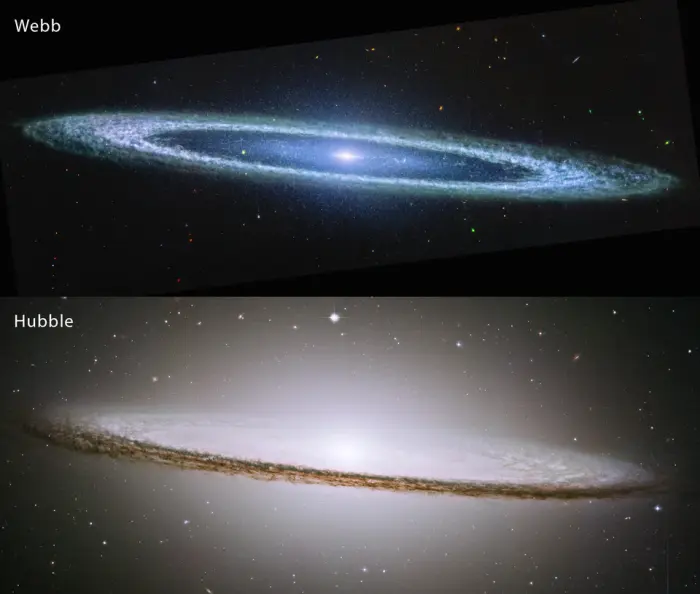
This image compares the view of the famous Sombrero Galaxy in mid-infrared light (top) and visible light (bottom). The James Webb Space Telescope’s MIRI (Mid-Infrared Instrument) reveals the smooth inner disk of the galaxy, while the Hubble Space Telescope’s visible light image shows the large and extended glow of the central bulge of stars. Both the Webb and Hubble images resolve the clumpy nature of the dust that makes up the Sombrero Galaxy’s outer ring. Credit: NASA, ESA, CSA, STScI, Hubble Heritage Team (STScI/AURA) (CC BY 4.0)
Location
The Sombrero Galaxy lies in the constellation Virgo, near the border with the neighbouring Corvus (the Crow). It can be found using the bright stars of the Sail (Spica’s Spanker), an asterism formed by the brightest stars of Corvus. A line drawn from Alchiba (Alpha Corvi) through Algorab (Delta Corvi) points in the direction of M104.
Alternatively, the Sombrero Galaxy can be found a little more than halfway from Kraz (Beta Corvi) to Porrima (Gamma Virginis), the second brightest star in Virgo (after Spica). The galaxy appears 11.5 degrees west of the bright Spica and 5.5 degrees northeast of Eta Corvi, the faint star next to Algorab (Delta Corvi).
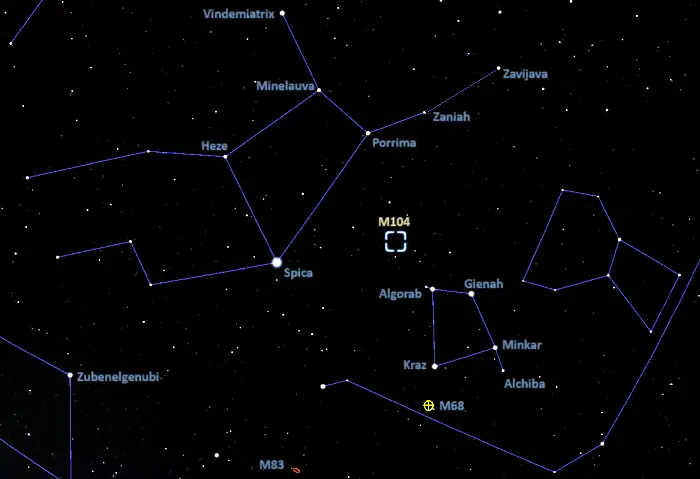
The location of the Sombrero Galaxy (M104), image: Stellarium
Spica’s Spanker is easy to locate because it appears near the bright Spica in the sky. The northern side of the asterism points towards Virgo’s brightest star. From the northern hemisphere, the easiest way to find Spica is to follow the arc of the Big Dipper’s handle, formed by Alioth, Mizar and Alkaid. The imaginary curved line extended away from the handle first leads to Arcturus and then to Spica.
The Sombrero Galaxy appears next to the Jaws asterism, a telescopic star pattern 27 arcminutes across, appearing northwest of the bright Messier galaxy.
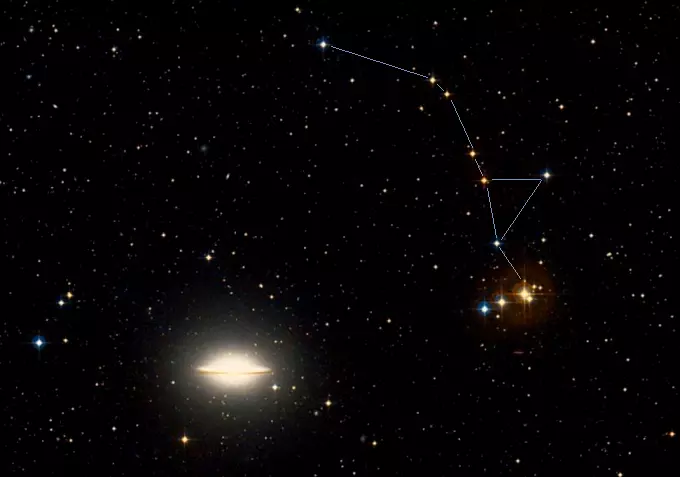
Jaws and the Sombrero Galaxy, image credit: ESO/Digitized Sky Survey 2 (CC BY 4.0)
Another telescopic asterism, popularly known as Stargate, lies southwest of M104 and the Jaws star pattern.
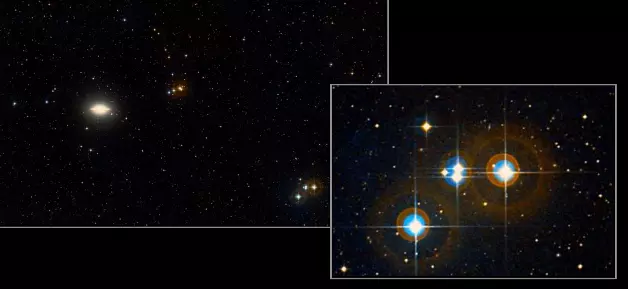
Stargate asterism, image credit: ESO/Digitized Sky Survey 2 (CC BY 4.0)
The Sombrero Galaxy is visible in binoculars and small telescopes. Small and medium telescopes reveal the galaxy’s spindle shape. The bright bulge and disk can be seen in 8-inch and larger instruments. The dark dust ring is visible in 10-inch and larger telescopes.
At declination -11° 37’, M104 is close enough to the celestial equator to be visible from virtually anywhere for at least part of the year.
The best time of the year to observe the Sombrero Galaxy and other deep sky objects in Virgo is during the month of May, when the constellation appears higher above the horizon around 9 pm.
Sombrero Galaxy – Messier 104
| Constellation | Virgo |
| Object type | Peculiar galaxy |
| Morphological type | Unclear (SA(s)a or E) |
| Right ascension | 12h 39m 59.43185902s |
| Declination | −11° 37′ 22.9961800″ |
| Apparent magnitude | 8.0 |
| Apparent size | 8.51′ × 5.01′ |
| Distance | 31.1 ± 1.0 million light-years (9.55 ± 0.31 megaparsecs) |
| Redshift | 0.003659 |
| Heliocentric radial velocity | 1,024 ± 5 km/s |
| Galactocentric velocity | 904 ± 7 km/s |
| Size | 105,400 by 56,900 light years (32.32 by 17.45 kiloparsecs) – 2MASS K-band total diameter; 94,900 light-years (29.09 kiloparsecs) – D25.0 B-band isophote |
| Names and designations | Sombrero Galaxy, Messier 104, M104, NGC 4594, LEDA 42407, PGC 42407, UGCA 293, MCG -02-32-020, IRAS 12373-1120, IRAS F12374-1120, IRAS 12373-1121, IRAS F12374-1120, 2MASX J12395949-1137230, AT20G J123959-113721, CRATES J123959-113709, 6dFGS gJ123959.4-113723, 1E 1237.3-1120, 2E 2814, 2E 1237.3-1120, NVSS J123959-113723, ICRF J123959.4-113722, IERS B1237-113, JCMTSE J123959.3-113726, JCMTSF J123959.3-113726, PMN J1239-1137, 1RXP J123959.2-113731, 1RXS J123959.8-113725, TGSSADR J123959.3-113723, VCS4 J1239-1137, WISH B1237.3-1121, WISEA J123959.44-113723.2, EQ 1237-113 |
Images
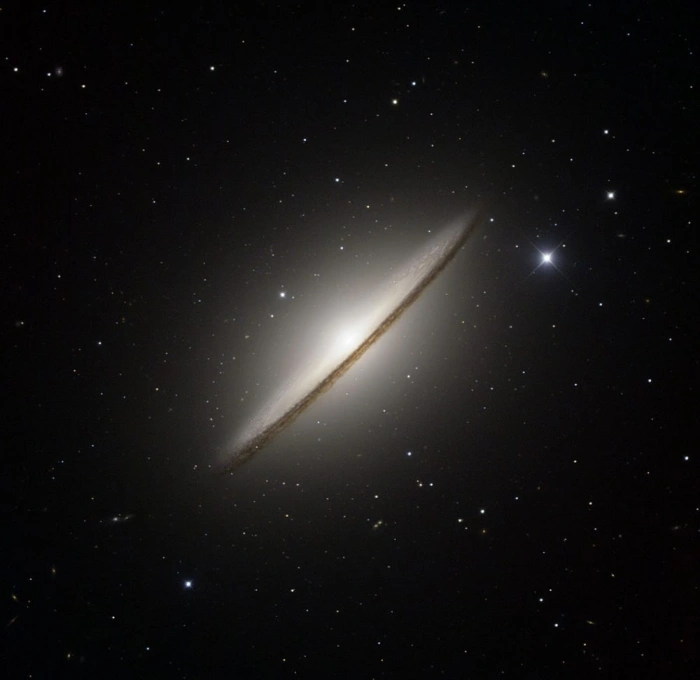
One of most famous spiral galaxies is Messier 104, widely known as the “Sombrero” (the Mexican hat) because of its particular shape. It is located towards the constellation Virgo (the ‘virgin’) and is the 104th object in the famous catalogue of deep-sky objects by French astronomer Charles Messier (1730 – 1817). This luminous and massive galaxy has a total mass of about 800 billion suns, and is notable for its dominant nuclear bulge, composed mainly of mature stars, and its nearly edge-on disc composed of stars, gas, and dust. The complexity of this dust is apparent directly in front of the bright nucleus, but is also evident in the dark absorbing lanes throughout the disc. A large number of small, diffuse objects can be seen as a swarm in the halo of Messier 104. Most of these are globular clusters, similar to those found in our own Milky Way, but Messier 104 has a much larger number of them. Despite having an exceptionally massive black hole at its centre, the galaxy is rather quiet, implying that the black hole is on a very stringent diet. This image is based on data acquired with the 1.5 m Danish telescope at the ESO La Silla Observatory in Chile, through three filters (B: 120 s, V: 100 s, R: 100 s). Image: ESO/IDA/Danish 1.5 m/R. Gendler and J.-E. Ovaldsen (CC BY 4.0)
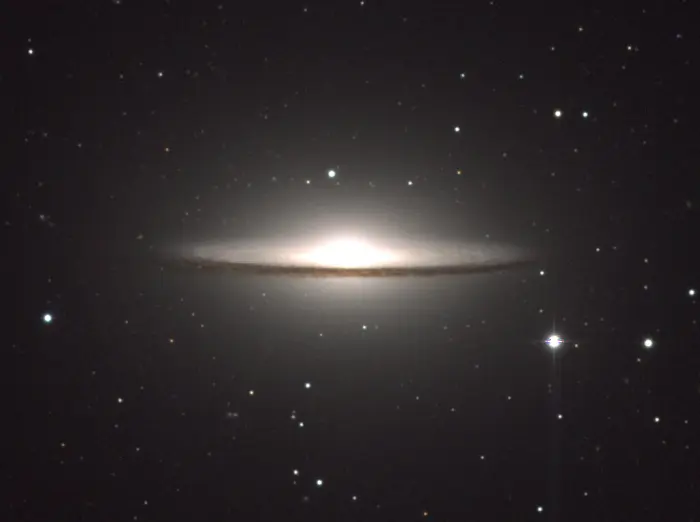
M104, or NGC 4594, is a spiral galaxy, type Sa/Sb, in the constellation Virgo. M104 is popularly known as the Sombrero Galaxy due to its dark rim of obscuring dust around a large central bulge. In this picture, the dust shows up as brown due to its absorption of blue light (an effect known as reddening), while the bulge has been reduced in significance by compressing the dynamic range of the data, better to show the inner details. Credit: Todd Boroson/NOIRLab/NSF/AURA (CC BY 4.0)
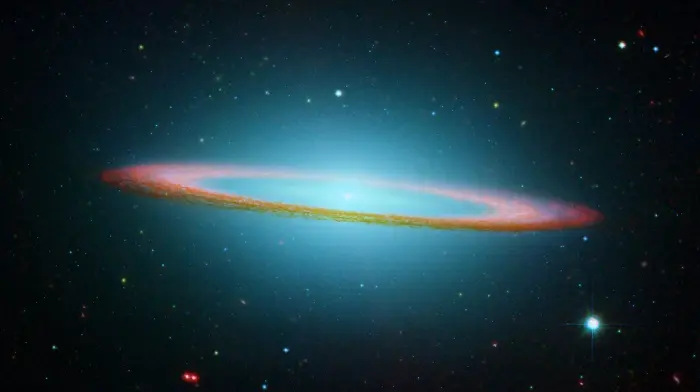
NASA/ESA Hubble Space Telescope and NASA’s Spitzer Space Telescope joined forces to create this striking composite image of one of the most popular sights in the universe. Messier 104 is commonly known as the Sombrero galaxy because in visible light, it resembles the broad-brimmed Mexican hat. However, in Spitzer’s striking infrared view, the galaxy looks more like a “bull’s eye.” Credit: NASA/JPL-Caltech and The Hubble Heritage Team (STScI/AURA) (PD)
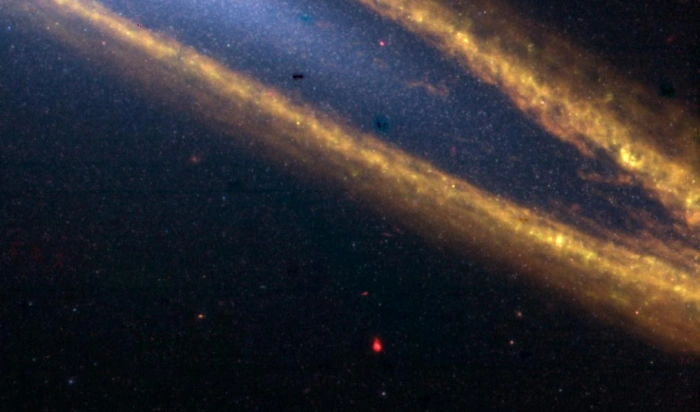
Part of the Sombrero Galaxy with JWST in mid-infrared. Credit: Meli Thev (CC BY 4.0)
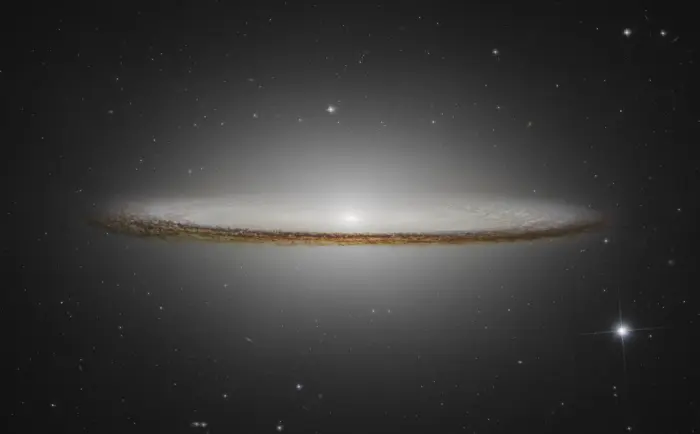
Sombrero Galaxy by the Hubble Space Telescope, image credit: NASA/ESA & Hubble (PD)
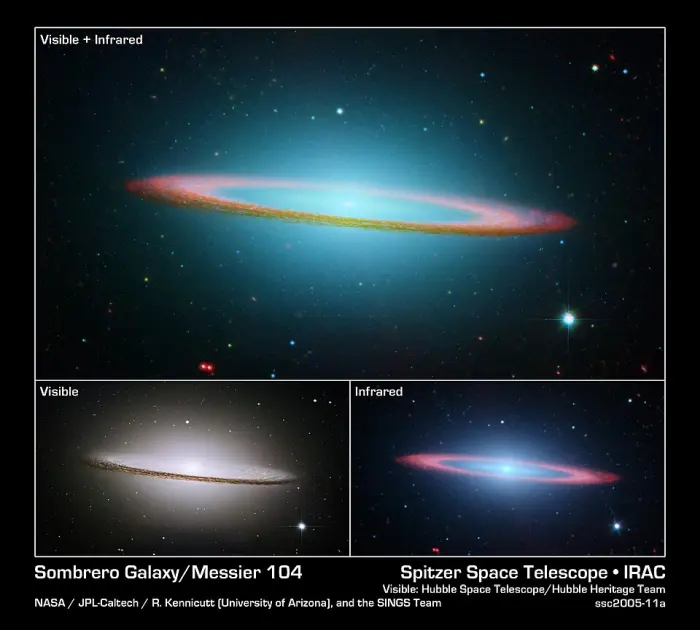
NASA’s Spitzer and Hubble Space Telescopes joined forces to create this striking composite image of one of the most popular sights in the universe. In Hubble’s visible light image (lower left panel), only the near rim of dust can be clearly seen in silhouette. Recent observations using Spitzer’s infrared array camera (lower right panel) uncovered the bright, smooth ring of dust circling the galaxy, seen in red. Spitzer’s infrared view of the starlight, piercing through the obscuring dust, is easily seen, along with the bulge of stars and an otherwise hidden disk of stars within the dust ring. Credit – Spitzer (infrared): NASA/JPL-Caltech/R. Kennicutt (University of Arizona), and the SINGS Team; Hubble (visible): NASA/Hubble Heritage Team (PD)
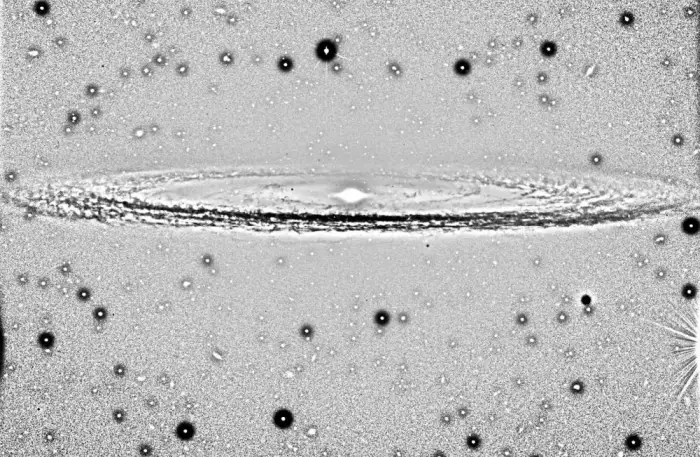
It is possible to follow the spiral structure of the Sombrero Galaxy almost all the way round. The dark areas around the stars and galaxies in the field are artefacts of the image processing. This galaxy is notable for its dominant nuclear bulge, composed primarily of mature stars, and its nearly edge-on disk composed of stars, gas, and intricately structured dust. The complexity of this dust, and the high resolution of this image, is most apparent directly in front of the bright nucleus, but is also very evident as dark absorbing lanes throughout the disk. A significant fraction of the galaxy disk is even visible on the far side of the source, despite its massive bulge. Technical information : The image has been processed to show the numerous dust bands in the central plane. It was made by dividing the V-band image by itself smoothed with a 2D gaussian profile (sigma: 10 pix); this removes the uniform areas and enhances the high spatial frequency features, e.g. the dust bands. Image processing by Mark Neeser (Kapteyn Institute, Groningen) and Richard Hook (ST/ECF, Garching, Germany). Image: ESO/P. Barthel (CC BY 4.0)
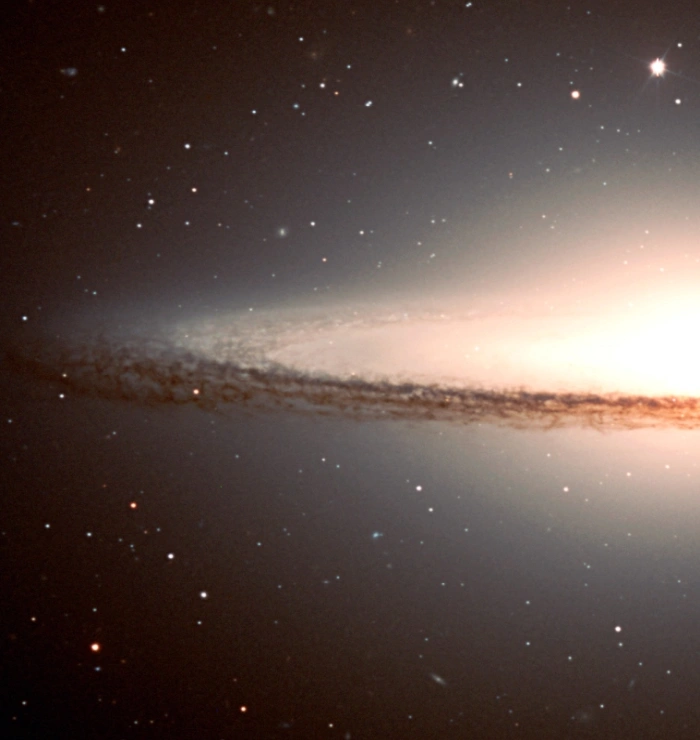
This is the eastern area of the Sombrero Galaxy, with the pronounced dust bands and many background galaxies. Image: ESO (CC BY 4.0)